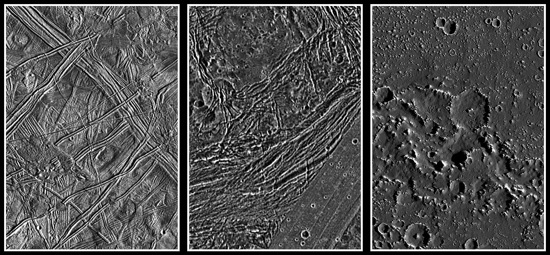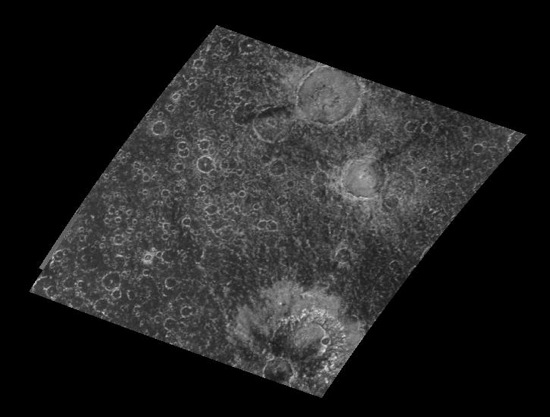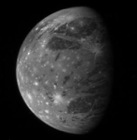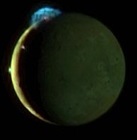Galilean Satellites Gallery:
Callisto
 The New Horizons spacecraft captured these images of Callisto from a distance of 4.7 million (left) and 4.2 million kilometres (right) respectively. Callisto has an ancient surface scared with impact craters. The youngest craters appear bright since they have excavated material relatively rich in water ice from beneath the dark dusty surface. Image: NASA/Johns Hopkins University Applied Physics Laboratory/Southwest Research Institute. The New Horizons spacecraft captured these images of Callisto from a distance of 4.7 million (left) and 4.2 million kilometres (right) respectively. Callisto has an ancient surface scared with impact craters. The youngest craters appear bright since they have excavated material relatively rich in water ice from beneath the dark dusty surface. Image: NASA/Johns Hopkins University Applied Physics Laboratory/Southwest Research Institute.

'Knobby Terrain' was found in one portion of Callisto by the Galileo spacecraft. The knobs are about 80-100 metres tall and contain ice and dust. As the ice erodes, the dark material apparently slides down and collects in low-lying areas. Over time, as the surface continues to erode, the icy knobs will likely disappear, producing a scene similar to the bottom inset. Image: NASA/JPL/Arizona State University, Academic Research Lab.

Spot the difference: These images show the similarites and differences between the three icy Galilean satellites Europa (left), Ganymede (middle) and Callisto (right). Callisto has the oldest surface, given away by the extensive number of craters that litter the dark, icy surface. Image: NASA/JPL/DLR

The giant impact basin Valhalla dominates this image. Many concentric raised rings were created in the impact event, and lighter material flooded into the central portion of the basin. Image: NASA/JPL.

A heavily cratered region in the southern hemisphere of Callisto shows craters ranging in diameter from 1.85km to over 70km. Some small craters have bright spots in their centres, these are central peaks of material. In large craters, there are central peaks or pits. The largest crater in this image, Thrainn, has a heavily eroded rim, while the crater at the northern margin, Audr, has a flat, smooth floor. Assuming that erosion has been roughly constant with time, scientists can infer that Audr is younger than Thrainn because of its intact crater rim and fresher appearance. Image: NASA/JPL/ASU.
 
« Previous Next »
|

